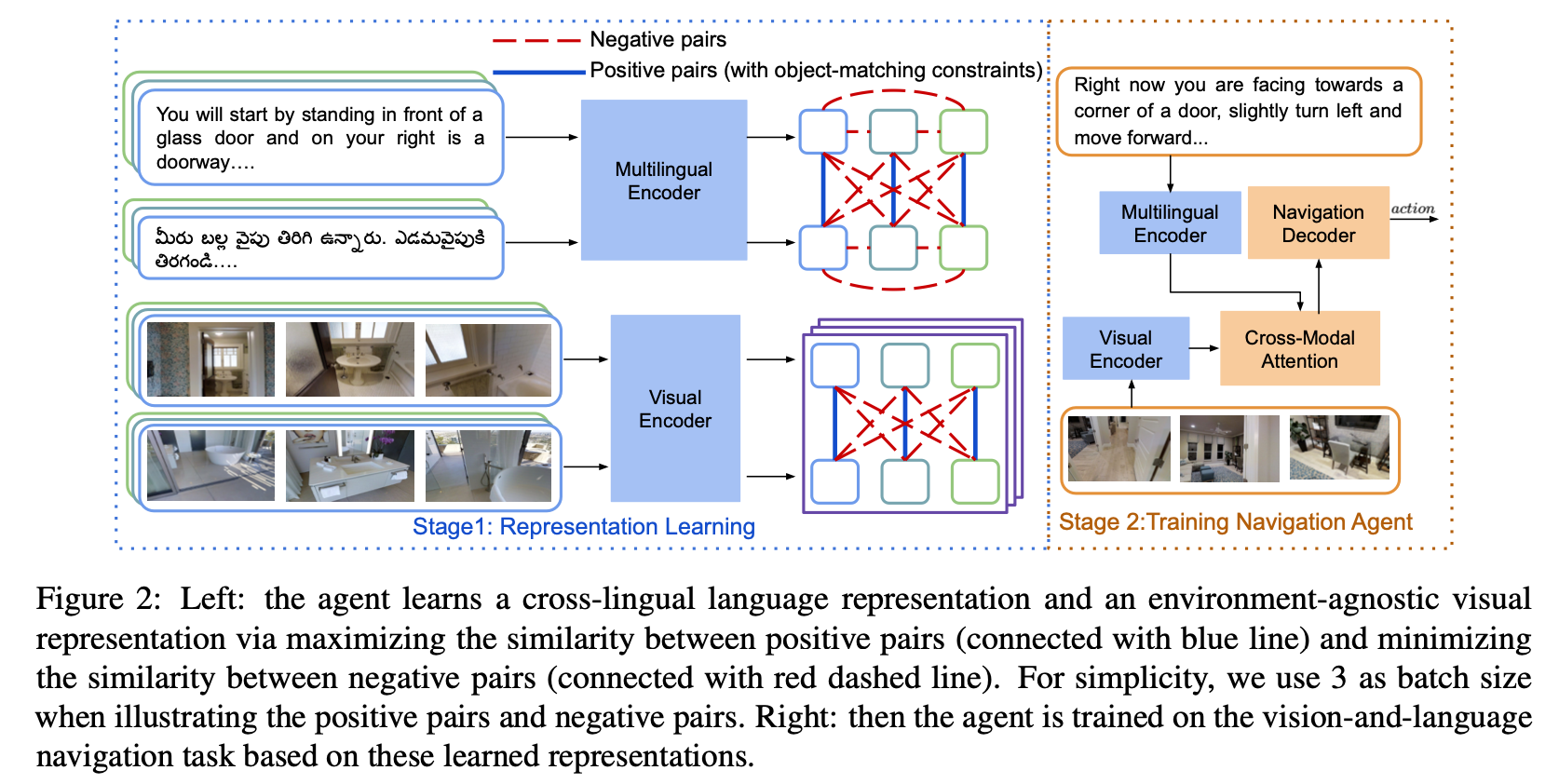CLEAR: Improving Vision-Language Navigation with Cross-Lingual, Environment-Agnostic Representations (Findings of NAACL 2022)
-
Authors: Jialu Li, Hao Tan, and Mohit Bansal (UNC Chapel Hill)
Vision-and-Language Navigation (VLN) tasks require an agent to navigate through the environment based on language instructions. In this paper, we aim to solve two key challenges in this task: utilizing multilingual instructions for improved instruction-path grounding and navigating through new environments that are unseen during training. To address these challenges, first, our agent learns a shared and visually-aligned cross-lingual language representation for the three languages (English, Hindi and Telugu) in the Room-Across-Room dataset. Our language representation learning is guided by text pairs that are aligned by visual information. Second, our agent learns an environment-agnostic visual representation by maximizing the similarity between semantically-aligned image pairs (with constraints on object-matching) from different environments. Our environment agnostic visual representation can mitigate the environment bias induced by low-level visual information. Empirically, %we show that our agent gets large improvements in all metrics when generalizing to unseen environments with the cross-lingual language representation and the environment-agnostic visual representation, and achieving the new state-of-the-art for multilingual agents on the Room-Across-Room dataset. on the Room-Across-Room dataset, we show that our multi-lingual agent gets large improvements in all metrics over the strong baseline model %(over state-of-the-art baselines) when generalizing to unseen environments with the cross-lingual language representation and the environment-agnostic visual representation. Furthermore, we show that our learned language and visual representations can be successfully transferred to the Room-to-Room and Cooperative Vision-and-Dialogue Navigation task, and present detailed qualitative and quantitative generalization and grounding analysis.
-
Follow instructions here to install Matterport3D simulators.
-
Install requirements:
pip install -r python_requirements.txt- Download data:
wget -r https://nlp.cs.unc.edu/data/clear-
Image features:
CLIP-ViT-B-32-views.tsvfor CLIP-ViT/32 features, andResNet-152-imagenet.tsvfor ResNet features. -
Training Data:
rxr_SPLIT_guide_multi.jsonl, whereSPLITistrain,val_seen, orval_unseen -
Data for detected objects in each view:
objects_27.json
For simplicity, we also provide the learned language and visual representation:
-
Language Representation:
encoder_best_val_unseen_loss -
Visual Representation:
visual_resnet_best_val_unseen_lossfor ResNet features, andvisual_clip_best_val_unseen_lossfor CLIP features
bash run/lang.bash 0
0 is the id of GPU.
bash run/visual.bash 0
0 is the id of GPU.
objects_constraints: path to the file containing objects in each view.
bash run/agent.bash 0
0 is the id of GPU.
-
dataset:RxR,R2R,CVDN -
load_encoder: path to learned language representation -
load_visual: path to learned visual representation -
feature_size:2048to use ResNet features,512to use CLIP-ViT/32 features
If you find this work useful, please consider citing:
@inproceedings{li2022clear,
title = {CLEAR: Improving Vision-Language Navigation with Cross-Lingual, Environment-Agnostic Representations},
author = {Jialu Li, Hao Tan, Mohit Bansal},
booktitle = {Findings of NAACL},
year = {2022}
}We thank the developers of EnvDrop, HAMT, CLIP for their public code release.
